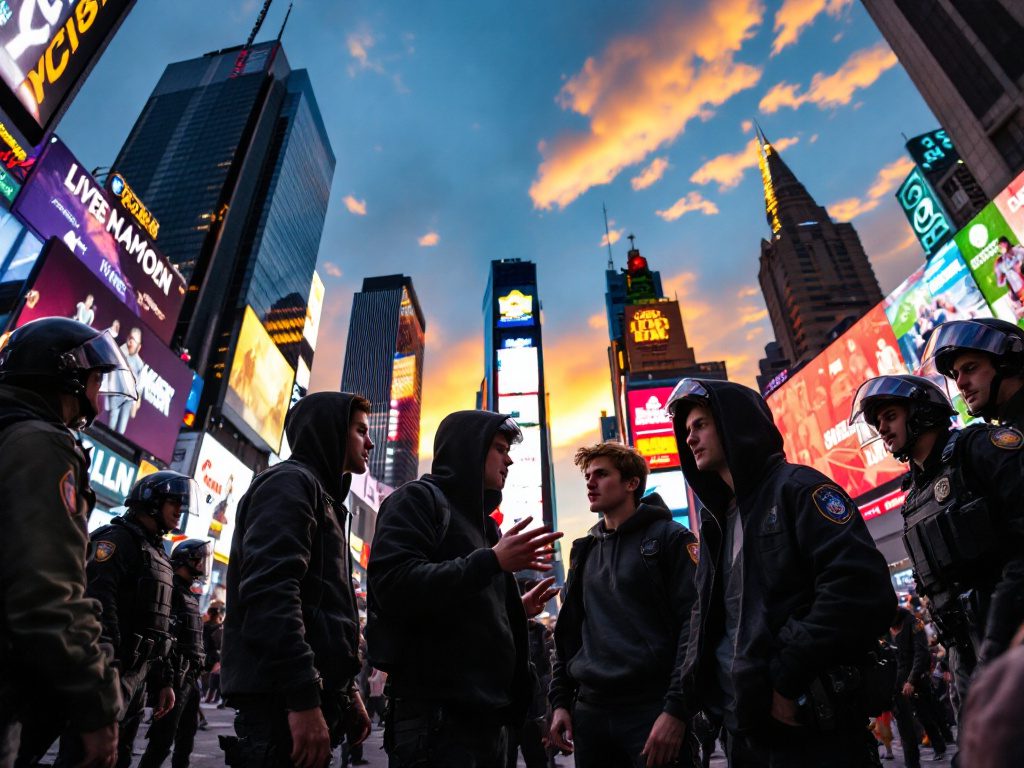A Saturday Night in Times Square Turns Violent
Friday’s fight after the Ryan Garcia vs. Rolly Romero boxing match should have been just another high-spirited night in Times Square, a spot where neon lights, tourists, and New Yorkers notoriously converge. Instead, a melee broke out that has since sent ripples through New York City’s corridors of power, reigniting a struggle over immigration, public safety, and the responsibilities of a modern sanctuary city. The violence wasn’t random. It stemmed from a group of young men—some as young as 12—linked to the notorious Venezuelan gang Tren de Aragua and its offshoot, Diablos de la 42.
According to NYPD reports and media footage, officers moved to intervene as the group attempted to rob two teenagers in one of New York’s most densely policed and tourist-laden areas. What followed looked more like a scene stolen from a turbulent movie script than a moment of real NYPD street policing. Officers were swarmed by the youthful crew, some of whom had already been identified in connection with a string of Central Park robberies. At least three suspects were apprehended—one a 12-year-old, another just 16. One teenager now faces assault, menacing, and even weapons charges. The youngest, released pending family court, is already back among the city’s makeshift migrant shelters.
How does this happen—two police officers boldly intervene only to be jumped by a frenzied group of teens in the heart of New York City? Headlines and cable news will point to one fact: NYPD officers are now on the frontline of a sprawling, disjointed migration emergency. In the last two years, New York’s embrace of sanctuary city policies has intersected with a humanitarian crisis south of the border, swelling the city’s shelter population and deeply taxing every public system.
Sanctuary Cities and the Strain on Public Resources
Mayor Eric Adams has often spoken about New York’s desire to remain a beacon for immigrants: “We’re proud of our values, but we need federal support.” There is a cost, however, to living up to progressive ideals without pragmatic planning. Over 180,000 migrants have arrived in New York City since 2022, according to city officials. Many have ended up in ad hoc shelters—shuttered hotels, gymnasiums, even old schools and churches. The resulting pressures have left neighborhoods juggling compassion and concern as headlines about crime—some involving migrant youth—fuel bitter political debates.
A closer look reveals a painful contradiction: communal spaces meant for recovery and dignity sometimes become the site of desperation and exploitation. NYPD officials, including veteran officers, have vented frustration at City Hall, arguing that current policies do not offer adequate resources or oversight to handle criminal behavior increasingly perpetrated by young migrants. Harvard professor Dr. Jacqueline Salazar, an expert in urban migration, notes, “Failing vulnerable youth in transition—without education or mentorship—almost guarantees they’ll fall into the clutches of the worst influences.”
The conservative backlash has been fierce, with right-wing pundits blaming President Biden and Democratic leaders for creating what they dub “lawless, open borders.” Yet, is this really a border crisis, or is it a crisis of urban poverty and neglect—fueled by deliberate underfunding and decades of missed opportunities? History shows us that scapegoating immigrants for crime is a bipartisan sport. In the 1990s, a surge in Central American migration sparked moral panic, though later, government studies revealed only a fraction of crimes were linked to new arrivals—most of whom simply sought safer, more stable lives.
“Sanctuary is not a free pass for criminality, but neither should we abandon the young and desperate to whatever fate the streets—or jail—might promise.” — Dr. Jacqueline Salazar, Harvard University
New York’s sanctuary city status exists not to shield crime, but to foster trust and help integrate newcomers, legal or not. The real tragedy lies in our aging infrastructure, political gridlock, and chronic lack of strategic investment in education, social work, and culturally competent policing. When those supports collapse, public safety suffers. It’s not the arrival itself that’s to blame—look to the systems meant to receive and transform trauma into hope.
What Does Accountability Look Like Now?
Beyond the clamor of Fox News and the finger-pointing at City Hall, a deeper question lingers—what does meaningful accountability look like when dealing with youth gangs, migrant or not? Progressive policies demand a tough, clear-eyed response to violent incidents, but they also require an honest reckoning with root causes. Failing to invest in the futures of migrant youth creates fertile soil for gang recruitment.
Reacting with crackdowns alone—arrests, deportations, and stricter policing—may win some headlines, but those approaches often perpetuate cycles of disenfranchisement. According to a 2023 Pew Research study, comprehensive youth engagement programs and trauma-informed intervention strategies are twice as effective at reducing recidivism as classic enforcement-based responses. The city’s own past proves the point. During the 1980s and 1990s, New York won steep declines in youth crime through investments in after-school jobs, targeted mentorship projects, and community-driven violence prevention.
Should we excuse violence or overlook the pain inflicted on victims and police officers? Absolutely not. But as the city lurches through this migration surge, demonizing all asylum seekers—as some in Albany and Washington are eager to do—solves nothing. Investing in prevention and integration must be at the core of any mature response. New York can remain a sanctuary, but only if it refuses to let either fearmongering or indifference write tomorrow’s headlines.
Taking stock after Times Square’s latest flash of chaos, two truths become clear: undermanaged migration will breed unrest, and underfunded services—in policing, housing, and youth engagement—leave everyone more vulnerable. Progressive values do not mean turning a blind eye to real dangers, but they do compel us to reject cynical narratives and fight for a city where safety and dignity exist for all.

